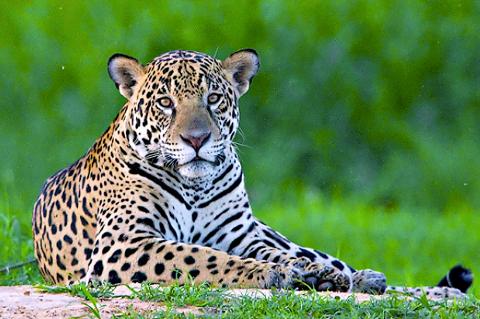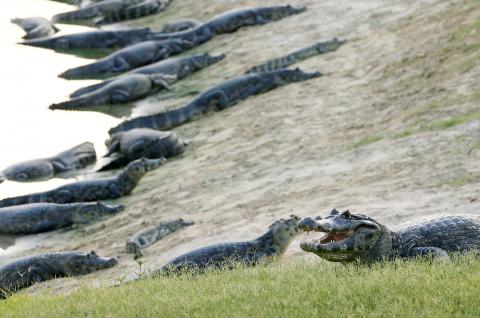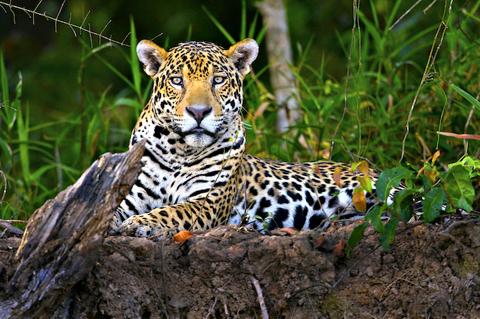The Transpantaneira Highway, despite its grand name, is an unfinished dirt road running 145 or so kilometers from the Brazilian town of Pocone into the Pantanal, a vast wetlands many consider South America’s finest destination for animal viewing.
But it’s not just a road: It’s a crocodilian slalom course. As I jolted along in a rented Fiat Uno on a late August night, my headlights caught the glare of dozens of red eyes staring in the near pitch-black far ahead. They belonged to Yacare caimans, alligator cousins that had decided the road was a comfortable resting spot.
There are literally millions of caimans in the Pantanal, and they don’t make way for anyone. So I weaved around them, remembering the story that the car rental agent had told me just a few hours earlier about the time he had to sleep in his truck because the road was so caiman-covered he couldn’t get by.

Photo: Bloomberg
I was luckier: Minutes later, I was turning onto the road to Pousada Rio Clarinho, the first of two lodges I would stay at during my Pantanal trip. There were no more caimans, but the road through dense woods was winding and deeply rutted, slowing me to a bumpy crawl. I flipped on my high beams as I rounded a curve, slammed on the brakes and uttered a very loud, very profane expression of surprise.
Just 3m ahead lumbered the oddest animal I had ever seen. Although it was maybe 1.5m long, there was barely any body: Most of it was taken up by a tubelike snout in front and a bushy tail in back that Wilma Flintstone might have used to dust furniture.
I had spotted a rare giant anteater — and I hadn’t even checked in.

Photo: Reuters
Things only got better. Waiting for me at the lodge was a dinner of roast chicken, rice, beans and salad that was part of the package at Rio Clarinho, where I was paying 150 Brazilian reais a night (or US$85 at 1.76 reais to the US dollar). That included a rustic but survivable room, three meals a day and a personal tour guide.
The Pantanal lives in the shadow of the Amazon, its mammoth neighbor to the north. I love the Amazon for its rivers and villages, its exotic fruits and its vastness. But for budget travelers looking for wildlife, it can’t compare to the Pantanal. Amazonian lodges are for the most part more expensive and farther from cities (and major airports), and the animals harder to spot — it’s literally a jungle out there. In the Pantanal, the jaguars may be evasive, but the capybaras, the hyacinth macaws, the giant anteaters and the ring-tailed coatis will practically pose for you if you approach quietly.
In the geographic center of South America, the Pantanal spreads over tens of thousands of square kilometers of wide-open flood plains and tropical dry forests in Paraguay, Bolivia and (mostly) Brazil.

Photo: Bloomberg
Vacationers heading to the Pantanal have lots of decisions to make: Should they go south, flying into Campo Grande (as most budget travelers do) or north (as I did) through Cuiaba? Which is better, the dry season or the wet? (Most favor the dry season, April to September, with more animals and less mud.) And should they book tours in advance or go it on their own?
Most book tours. But I decided to go freelance, reserving my own rooms at the last minute, thus gaining some flexibility while saving additional tour charges. I’d have to skip out on expensive daylong boat excursions where the main purpose is to spot jaguars. But who needs jaguars when your welcoming committee includes a giant anteater?
Rio Clarinho was a bit shabby — its bathrooms could use an overhaul — but a likable, honest place. The owner, Afranio, told me that a 32-year-old Pantanal native named Tuca would be “completely at my disposition” as a guide for two days.
That’s not a phrase I hear often as a frugal traveler. But it was wonderfully, amazingly true. Over the next day and a half, Tuca and I searched for wildlife on a day hike, a night hike, a horseback ride, a boat trip and a sunrise-viewing trip to a wooden tower rising above the trees on the property. We also went fishing with bamboo poles and chunks of meat that vultures would snatch up if we left the bait pail unattended.
Tuca didn’t speak much English, but he had an amazing knack for tracking down animals. We came across capuchin monkeys and tamarins swinging through the trees, red-footed tortoises retracting into their shells, cutias (small rodents), marsh deer, Brazilian tapirs, a raccoonlike ringed-tail coati dashing across our path, and a small anteater called a southern tamandua climbing up a tree branch. Once, hearing a flutter of wings, Tuca said: “Vultures. A jaguar killed something” and began hacking his way into the brush with his machete. Sure enough, there was the carcass of a tapir under a cloud of flies. The jaguar, alas, was gone.
The highlights came on our river excursion and nighttime walk. On the Clarinho river, we came across friendly giant otters, most of whom greeted us with a sound that the more immature might compare to a whoopee cushion. One was chomping down on a captured fish as if it were a candy bar.
The other solo traveler in the lodge, a Briton named Gabriel, joined us for a night hike. He was a bit tense about being on foot.
“If one of us steps on a coral snake, we’re finished,” he said. “It’s like a game of Russian roulette, Pantanal style.”
But we saw no snakes, just crab-eating foxes and another southern tamandua.
Then, toward the end of the walk, Gabriel caught a glimpse of two red eyes in road ahead. We hurried up to the spot and shined our lights into the woods.
“Jaguatirica!” Tuca whispered.
An ocelot, the spotted cat that looks like a mini-jaguar, stared at us from 12m away.
I’m a sucker for mammals and reptiles, but those with the most incentive to come to the Pantanal are birdwatchers. I had to borrow binoculars, but I admit that the birds admirably filled in the gaps between mammal and reptile-spottings. It’s amazingly easy to find hyacinth macaws, toucans, parrots, owls, storks and my favorite, the flamingo-without-a-neck. (It’s really a roseate spoonbill.)
My second stop was Pouso Alegre, a more upscale place where the rooms feature things like hooks, shelves and bathroom doors that fully close. The lodge is set in a beautiful wide-open landscape, meaning you can wander off on your own without getting lost. The prices aren’t bad, either: US$136 for a single (although I weaseled a discount by having the owner of Rio Clarinho call and plead my case as a poor traveler).
But the best part is probably its owner, Luiz Vicente Campos Filho, who has encyclopedic knowledge of the animals and especially the birds that live on the land. That’s not surprising since the ranch that the lodge sits on has been in his family for a century; what is surprising is that he speaks excellent English and finds time to serve as guide to non-tour-group travelers when he can. (I got in several trips with him — including a night ride when we spotted another giant anteater.)
The style at both pousadas was sublimely relaxed. It’s hot in the Pantanal, so activities largely cease from late morning to midafternoon, with hammock time filling the gaps before and after lunch, which at both places was buffet style. Added variety and desserts made by Luiz Vicente’s charming mom, Zelia Perfeit, gave Pouso Alegre the culinary edge.
With no dedicated guide, I had to fend for myself more at Pouso Alegre. I wandered off on my own some, although I didn’t stray far from the main road, under orders from Dona Zelia. I spotted a deer or two and gawked at the huge jabirus in their nest above the road, but found myself drawn more often to the adorable, overgrown rodents known as capybaras. Weighing in around 45kg and looking like mutant-size groundhogs, capybaras’ first line of defense against humans approaching with zoom lenses is to stand perfectly still. Then they “hide” by lumbering into knee-deep water or emit an odd bark that sounds like a pig imitating a German shepherd. I wanted to take one home.
Was arranging my own tour the right call? It was certainly cheaper and would have been more so if I had been traveling with a friend to split the rental car with and share a room. But guided trips start around US$170 a day, also quite reasonable, and guarantee you an English-speaking guide. For me, the flexibility made it worth it. I chose the second lodge only after hearing reviews from other travelers and had no problem getting a last-minute room, even in the busy month of August, when dry season overlaps with high season for Europeans and Americans.
That’s the kind of flexibility it’s hard to have in the Amazon, where reservations are advisable, as lodges could be hundreds of kilometers and a boat trip apart, as opposed to a 20-minute drive down the road.
By comparison, dodging a few lazy caimans on a dirt highway is a breeze.
On the Net: pousadarioclarinho.com.br, pousalegre.com.br and pantanalecosafari.com.br

On April 26, The Lancet published a letter from two doctors at Taichung-based China Medical University Hospital (CMUH) warning that “Taiwan’s Health Care System is on the Brink of Collapse.” The authors said that “Years of policy inaction and mismanagement of resources have led to the National Health Insurance system operating under unsustainable conditions.” The pushback was immediate. Errors in the paper were quickly identified and publicized, to discredit the authors (the hospital apologized). CNA reported that CMUH said the letter described Taiwan in 2021 as having 62 nurses per 10,000 people, when the correct number was 78 nurses per 10,000

As we live longer, our risk of cognitive impairment is increasing. How can we delay the onset of symptoms? Do we have to give up every indulgence or can small changes make a difference? We asked neurologists for tips on how to keep our brains healthy for life. TAKE CARE OF YOUR HEALTH “All of the sensible things that apply to bodily health apply to brain health,” says Suzanne O’Sullivan, a consultant in neurology at the National Hospital for Neurology and Neurosurgery in London, and the author of The Age of Diagnosis. “When you’re 20, you can get away with absolute

May 5 to May 11 What started out as friction between Taiwanese students at Taichung First High School and a Japanese head cook escalated dramatically over the first two weeks of May 1927. It began on April 30 when the cook’s wife knew that lotus starch used in that night’s dinner had rat feces in it, but failed to inform staff until the meal was already prepared. The students believed that her silence was intentional, and filed a complaint. The school’s Japanese administrators sided with the cook’s family, dismissing the students as troublemakers and clamping down on their freedoms — with

As Donald Trump’s executive order in March led to the shuttering of Voice of America (VOA) — the global broadcaster whose roots date back to the fight against Nazi propaganda — he quickly attracted support from figures not used to aligning themselves with any US administration. Trump had ordered the US Agency for Global Media, the federal agency that funds VOA and other groups promoting independent journalism overseas, to be “eliminated to the maximum extent consistent with applicable law.” The decision suddenly halted programming in 49 languages to more than 425 million people. In Moscow, Margarita Simonyan, the hardline editor-in-chief of the